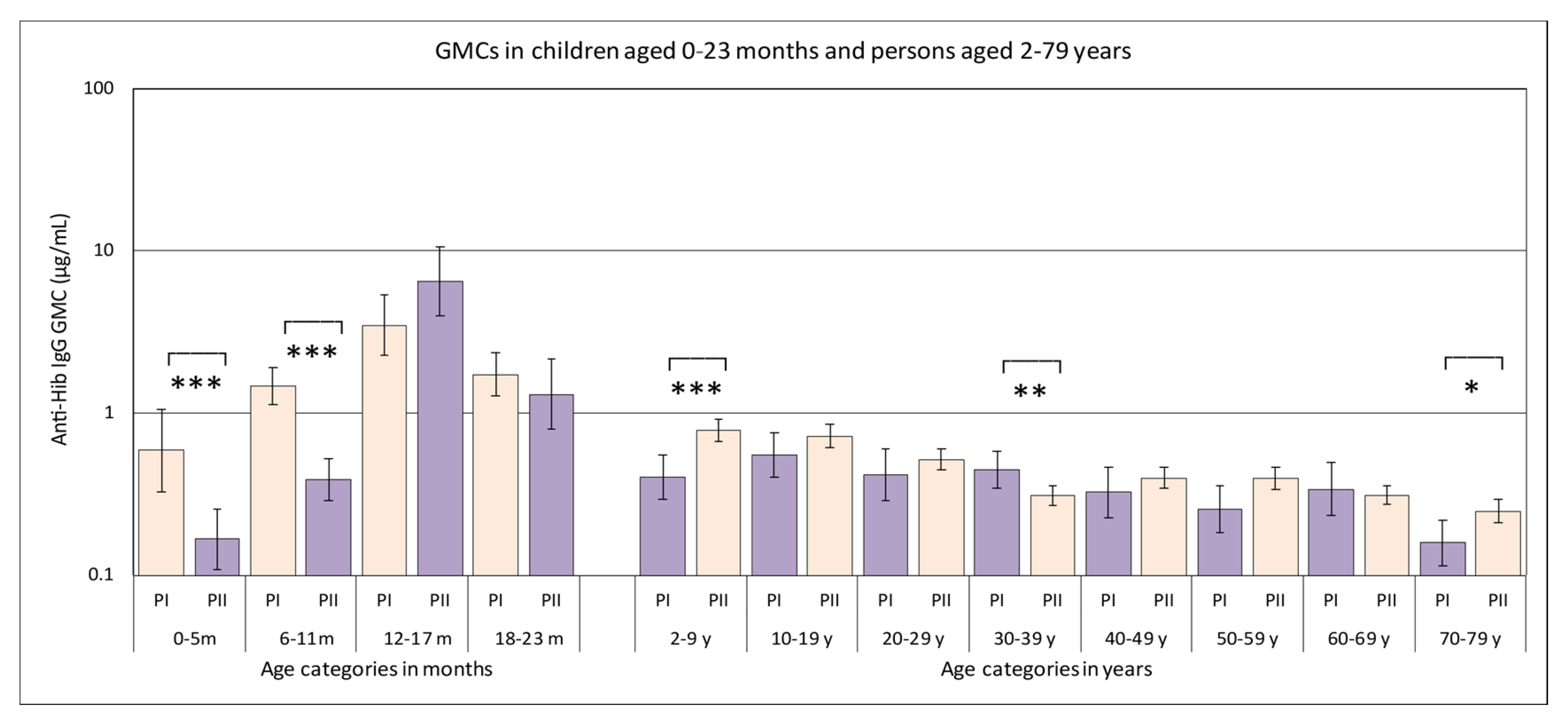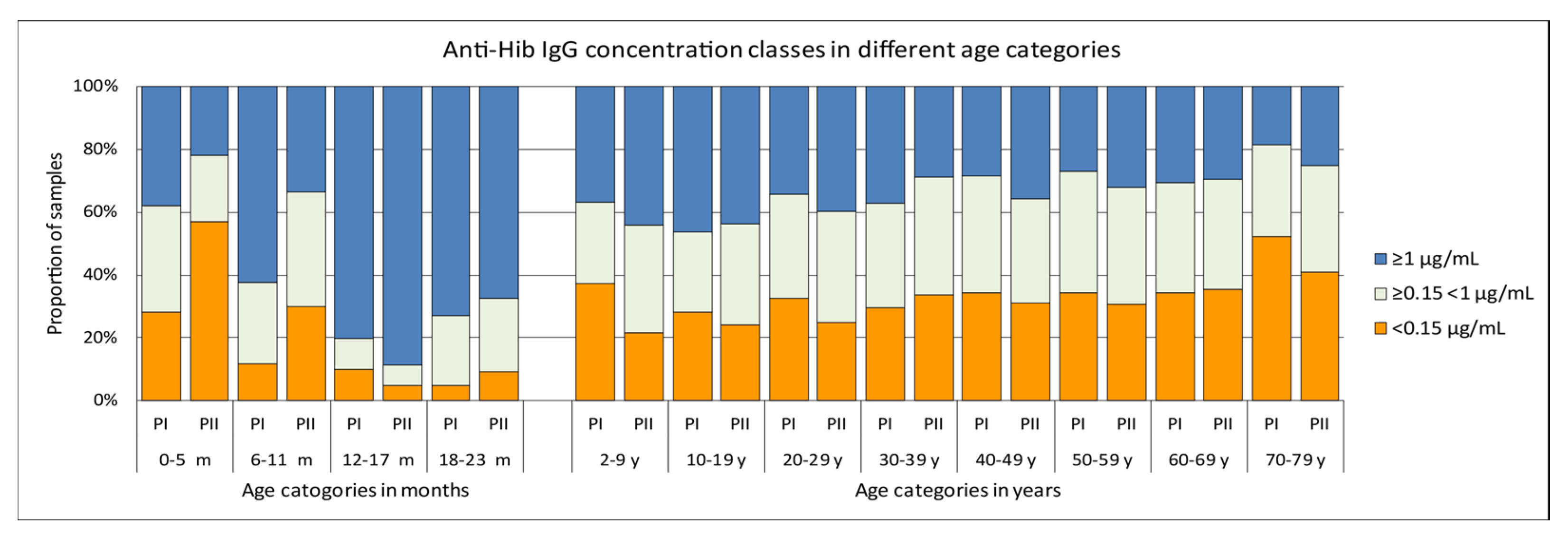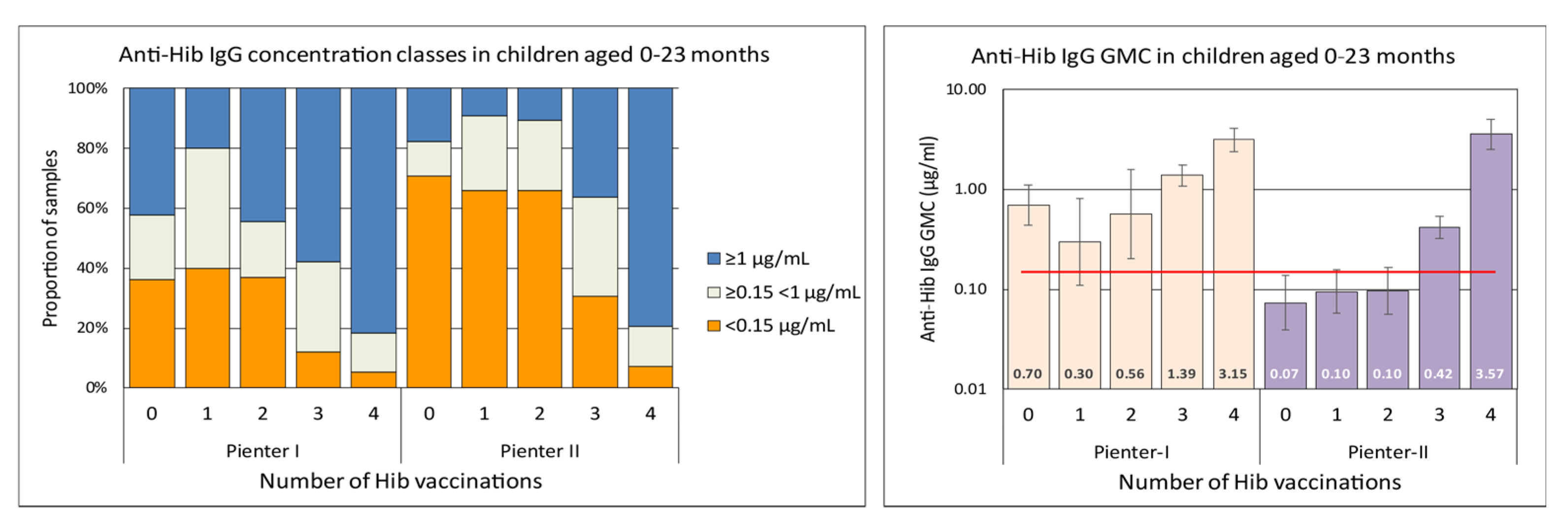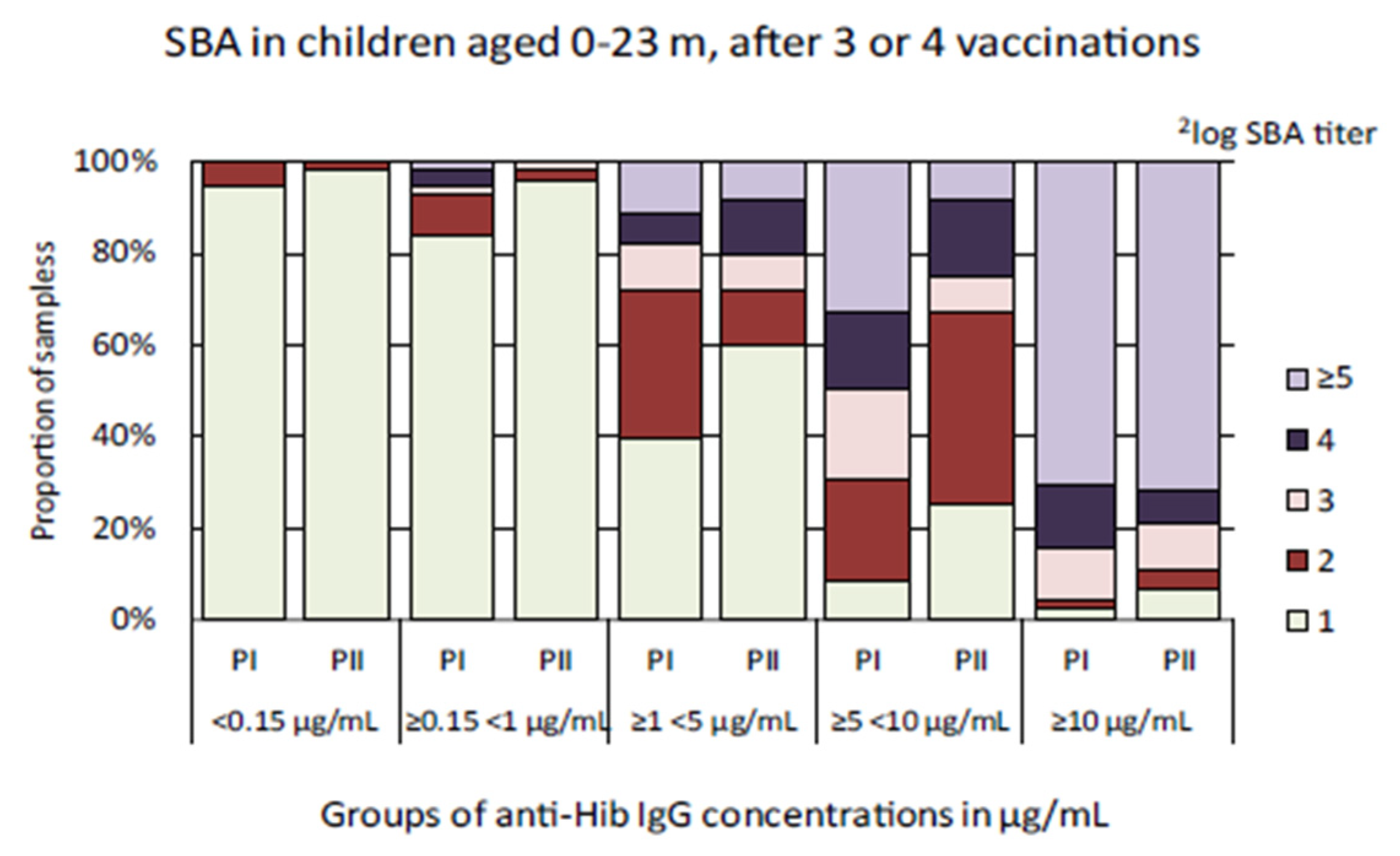Lagging Immune Response to Haemophilus influenzae Serotype b (Hib) Conjugate Vaccine after the Primary Vaccination with Hib of Infants in The Netherlands
Abstract
1. Introduction
2. Materials and Methods
2.1. Study Population
2.2. Serology
2.3. Statistical Analysis
3. Results
3.1. Hib-Specific IgG Levels in the Pienter-I and Pienter-II Study
3.2. Hib-Specific Serum Bactericidal Assay
4. Discussion
5. Conclusions
Author Contributions
Funding
Acknowledgments
Conflicts of Interest
References
- Rijkers, G.T.; Vermeer-de Bondt, P.E.; Spanjaard, L.; Breukels, M.A.; Sanders, E.A. Return of Haemophilus influenzae type b infections. Lancet 2003, 361, 1563–1564. [Google Scholar] [CrossRef]
- Spanjaard, L.; van den Hof, S.; de Melker, H.E.; Vermeer-de Bondt, P.E.; van der Ende, A.; Rijkers, G.T. Increase in the number of invasive Haemophilus influenzae type b infections. Ned. Tijdschr. Geneeskd. 2005, 149, 2738–2742. [Google Scholar] [PubMed]
- van Den Hof, S.; de Melker, H.E.; Berbers, G.A.; van Der Kraak, P.H.; Spaendonck, M.A. Antibodies to Haemophilus influenzae serotype b in The Netherlands a few years after the introduction of routine vaccination. Clin. Infect. Dis. 2001, 32, 2–8. [Google Scholar] [CrossRef] [PubMed]
- van Lier, E.A.; Oomen, P.J.; Oostenbrug, M.W.; Zwakhals, S.L.; Drijfhout, I.H.; de Hoogh, P.A.; de Melker, H.E. High vaccination coverage of the National Immunization Programme in The Netherlands. Ned. Tijdschr. Geneeskd. 2009, 153, 950–957. [Google Scholar]
- De Melker, H.E.; Conyn-van Spaendonck, M.A. Immunosurveillance and the evaluation of national immunization programmes: A population-based approach. Epidemiol. Infect. 1998, 121, 637–643. [Google Scholar] [CrossRef]
- van der Klis, F.R.; Mollema, L.; Berbers, G.A.; de Melker, H.E.; Coutinho, R.A. Second national serum bank for population-based seroprevalence studies in The Netherlands. Neth. J. Med. 2009, 67, 301–308. [Google Scholar]
- Phipps, D.C.; West, J.; Eby, R.; Koster, M.; Madore, D.V.; Quataert, S.A. An ELISA employing a Haemophilus influenzae type b oligosaccharide-human serum albumin conjugate correlates with the radioantigen binding assay. J. Immunol. Methods 1990, 135, 121–128. [Google Scholar] [CrossRef]
- Mariani, M.; Luzzi, E.; Proietti, D.; Mancianti, S.; Casini, D.; Costantino, P.; van Gageldonk, P.; Berbers, G. A competitive enzyme-linked immunosorbent assay for measuring the levels of serum antibody to Haemophilus influenzae type b. Clin. Diagn. Lab. Immunol. 1998, 5, 667–674. [Google Scholar] [CrossRef]
- de Voer, R.M.; Schepp, R.M.; Versteegh, F.G.; van der Klis, F.R.; Berbers, G.A. Simultaneous detection of Haemophilus influenzae type b polysaccharide-specific antibodies and Neisseria meningitidis serogroup A, C, Y, and W-135 polysaccharide-specific antibodies in a fluorescent-bead-based multiplex immunoassay. Clin. Vaccine Immunol. 2009, 16, 433–436. [Google Scholar] [CrossRef][Green Version]
- Schouls, L.; van der Heide, H.; Witteveen, S.; Zomer, B.; van der Ende, A.; Burger, M.; Schot, C. Two variants among Haemophilus influenzae serotype b strains with distinct bcs4, hcsA and hcsB genes display differences in expression of the polysaccharide capsule. BMC Microbiol. 2008, 8, 35. [Google Scholar] [CrossRef]
- WHO. Immunological Basis for Immunization: Haemophilus Influenzae Type B Vaccines; World Health Organization: Geneva, Switzerland, 2007. [Google Scholar]
- de Melker, H.E.; van den Hof, S.; Berbers, G.A.; Conyn-van Spaendonck, M.A. Evaluation of the national immunisation programme in The Netherlands: Immunity to diphtheria, tetanus, poliomyelitis, measles, mumps, rubella and Haemophilus influenzae type b. Vaccine 2003, 21, 716–720. [Google Scholar] [CrossRef]
- Eskola, J.; Kayhty, H. Early immunization with conjugate vaccines. Vaccine 1998, 16, 1433–1438. [Google Scholar] [CrossRef]
- Pollabauer, E.M.; Petermann, R.; Ehrlich, H.J. The influence of carrier protein on the immunogenicity of simultaneously administered conjugate vaccines in infants. Vaccine 2009, 27, 1674–1679. [Google Scholar] [CrossRef] [PubMed]
- Dagan, R.; Poolman, J.; Siegrist, C.A. Glycoconjugate vaccines and immune interference: A review. Vaccine 2010, 28, 5513–5523. [Google Scholar] [CrossRef]
- Carlsson, R.M.; Claesson, B.A.; Kayhty, H.; Selstam, U.; Iwarson, S. Studies on a Hib-tetanus toxoid conjugate vaccine: Effects of co-administered tetanus toxoid vaccine, of administration route and of combined administration with an inactivated polio vaccine. Vaccine 1999, 18, 468–478. [Google Scholar] [CrossRef]
- Rennels, M.B.; Englund, J.A.; Bernstein, D.I.; Losonsky, G.A.; Anderson, E.L.; Pichichero, M.E.; Munoz, F.M.; Wolff, M.C. Diminution of the anti-polyribosylribitol phosphate response to a combined diphtheria-tetanus-acellular pertussis/Haemophilus influenzae type b vaccine by concurrent inactivated poliovirus vaccination. Pediatr. Infect. Dis. J. 2000, 19, 417–423. [Google Scholar] [CrossRef] [PubMed]
- Eskola, J.; Ward, J.; Dagan, R.; Goldblatt, D.; Zepp, F.; Siegrist, C.A. Combined vaccination of Haemophilus influenzae type b conjugate and diphtheria-tetanus-pertussis containing acellular pertussis. Lancet 1999, 354, 2063–2068. [Google Scholar] [CrossRef]
- Daum, R.S.; Zenko, C.E.; Given, G.Z.; Ballanco, G.A.; Parikh, H.; Germino, K. Magnitude of interference after diphtheria-tetanus toxoids-acellular pertussis/Haemophilus influenzae type b capsular polysaccharide-tetanus vaccination is related to the number of doses administered. J. Infect. Dis. 2001, 184, 1293–1299. [Google Scholar] [CrossRef] [PubMed]
- McVernon, J.; Andrews, N.; Slack, M.P.; Ramsay, M.E. Risk of vaccine failure after Haemophilus influenzae type b (Hib) combination vaccines with acellular pertussis. Lancet 2003, 361, 1521–1523. [Google Scholar] [CrossRef]
- Southern, J.; McVernon, J.; Gelb, D.; Andrews, N.; Morris, R.; Crowley-Luke, A.; Goldblatt, D.; Miller, E. Immunogenicity of a fourth dose of Haemophilus influenzae type b (Hib) conjugate vaccine and antibody persistence in young children from the United Kingdom who were primed with acellular or whole-cell pertussis component-containing Hib combinations in infancy. Clin. Vaccine Immunol. 2007, 14, 1328–1333. [Google Scholar]
- Collins, S.; Litt, D.; Almond, R.; Findlow, J.; Linley, E.; Ramsay, M.; Borrow, R.; Ladhani, S. Haemophilus influenzae type b (Hib) seroprevalence and current epidemiology in England and Wales. J. Infect. 2018, 76, 335–341. [Google Scholar] [CrossRef] [PubMed]




| Age Category | Pienter I | Pienter II | ||||
|---|---|---|---|---|---|---|
| n | GMC | 95% CI | n | GMC | 95% CI | |
| 0–5 month *** | 50 | 0.59 | 0.33–1.05 | 114 | 0.17 | 0.11–0.25 |
| 6–11 month *** | 201 | 1.48 | 1.14–1.92 | 181 | 0.39 | 0.29–0.52 |
| 12–17 month | 112 | 3.48 | 2.26–5.36 | 61 | 6.51 | 4.01–10.56 |
| 18–23 month | 85 | 1.73 | 1.28–2.34 | 43 | 1.31 | 0.80–2.14 |
| 2–9 year *** | 212 | 0.40 | 0.30–0.55 | 680 | 0.78 | 0.67–0.92 |
| 10–19 year | 225 | 0.55 | 0.40–0.75 | 694 | 0.72 | 0.61–0.85 |
| 20–29 year | 129 | 0.42 | 0.29–0.60 | 693 | 0.52 | 0.45–0.60 |
| 30–39 year ** | 224 | 0.44 | 0.34–0.58 | 705 | 0.31 | 0.27–0.36 |
| 40–49 year | 168 | 0.32 | 0.23–0.46 | 630 | 0.40 | 0.34–0.46 |
| 50–59 year | 171 | 0.26 | 0.18–0.36 | 628 | 0.39 | 0.34–0.46 |
| 60–69 year | 131 | 0.34 | 0.23–0.49 | 721 | 0.31 | 0.27–0.36 |
| 70–79 year * | 144 | 0.16 | 0.11–0.22 | 548 | 0.25 | 0.21–0.29 |
| Anti-Hib IgG Concentration Range | Study | n | GMC | 95% CI | GMT | 95% CI |
|---|---|---|---|---|---|---|
| <0.15 µg/mL | Pienter-I | 18 | 0.05 | 0.04–0.08 | 1.04 | 0.96–1.13 |
| Pienter-II | 48 | 0.04 | 0.03–0.06 | 1.02 | 0.99–1.04 | |
| ≥0.15 < 1 µg/mL * | Pienter-I | 56 | 0.38 | 0.33–0.44 | 1.17 | 1.06–1.30 |
| Pienter-II | 65 | 0.39 | 0.34–0.45 | 1.04 | 0.99–1.09 | |
| ≥1 < 5 µg/mL | Pienter-I | 78 | 2.28 | 2.08–2.51 | 1.87 | 1.63–2.14 |
| Pienter-II | 50 | 2.19 | 1.90–2.51 | 1.63 | 1.35–1.97 | |
| ≥5 <10 µg/mL * | Pienter-I | 36 | 7.08 | 6.64–7.54 | 3.25 | 2.70–3.92 |
| Pienter-II | 12 | 6.83 | 5.90–7.93 | 2.19 | 1.47–3.27 | |
| ≥10 µg/mL | Pienter-I | 44 | 18.81 | 15.65–22.61 | 5.21 | 4.56–5.96 |
| Pienter-II | 28 | 23.34 | 18.58–29.32 | 4.66 | 3.78–5.75 |
© 2020 by the authors. Licensee MDPI, Basel, Switzerland. This article is an open access article distributed under the terms and conditions of the Creative Commons Attribution (CC BY) license (http://creativecommons.org/licenses/by/4.0/).
Share and Cite
Schouls, L.; Schot, C.; de Voer, R.M.; van der Klis, F.; Knol, M.; Tcherniaeva, I.; Berbers, G. Lagging Immune Response to Haemophilus influenzae Serotype b (Hib) Conjugate Vaccine after the Primary Vaccination with Hib of Infants in The Netherlands. Vaccines 2020, 8, 347. https://doi.org/10.3390/vaccines8030347
Schouls L, Schot C, de Voer RM, van der Klis F, Knol M, Tcherniaeva I, Berbers G. Lagging Immune Response to Haemophilus influenzae Serotype b (Hib) Conjugate Vaccine after the Primary Vaccination with Hib of Infants in The Netherlands. Vaccines. 2020; 8(3):347. https://doi.org/10.3390/vaccines8030347
Chicago/Turabian StyleSchouls, Leo, Corrie Schot, Richarda M. de Voer, Fiona van der Klis, Mirjam Knol, Irina Tcherniaeva, and Guy Berbers. 2020. "Lagging Immune Response to Haemophilus influenzae Serotype b (Hib) Conjugate Vaccine after the Primary Vaccination with Hib of Infants in The Netherlands" Vaccines 8, no. 3: 347. https://doi.org/10.3390/vaccines8030347
APA StyleSchouls, L., Schot, C., de Voer, R. M., van der Klis, F., Knol, M., Tcherniaeva, I., & Berbers, G. (2020). Lagging Immune Response to Haemophilus influenzae Serotype b (Hib) Conjugate Vaccine after the Primary Vaccination with Hib of Infants in The Netherlands. Vaccines, 8(3), 347. https://doi.org/10.3390/vaccines8030347





